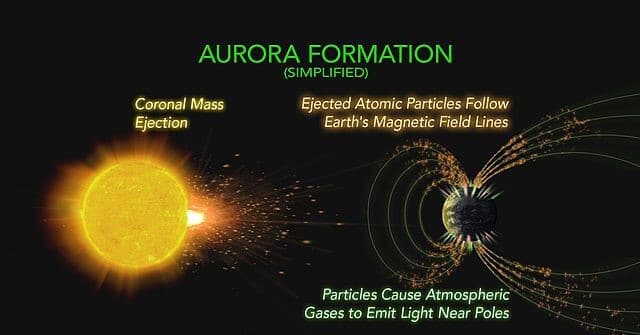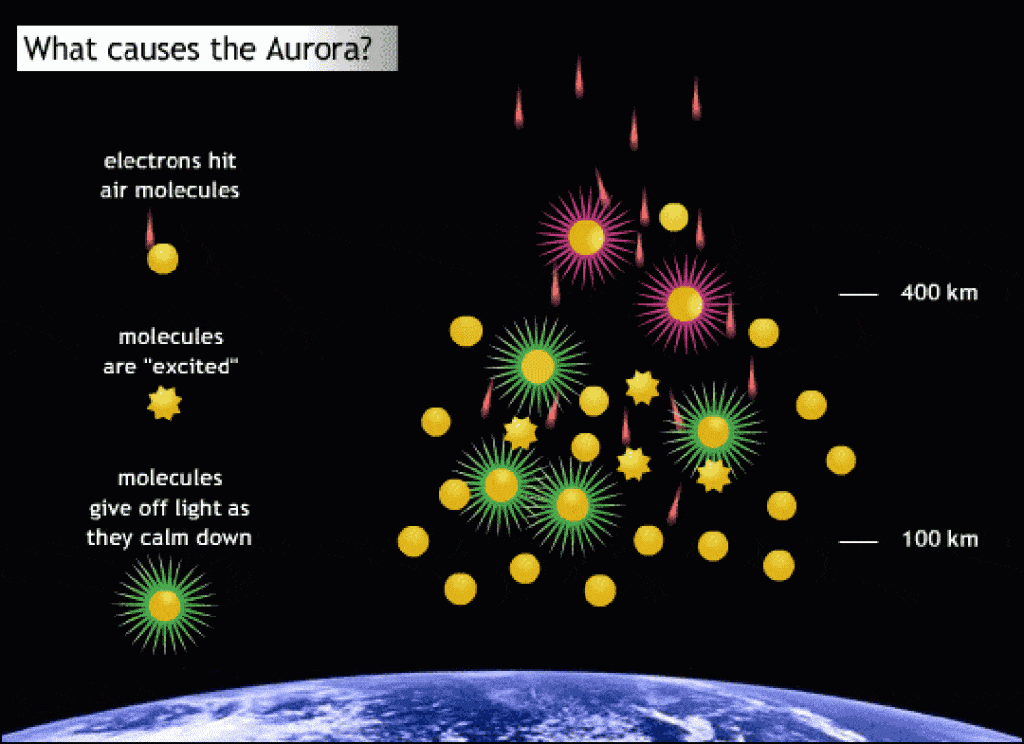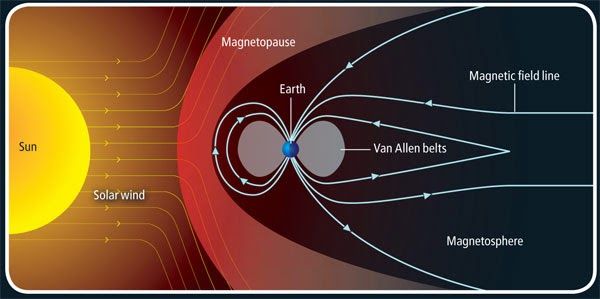In this article, You will read, Aurora Borealis and Aurora Australis for UPSC.
What is Aurora?
An Aurora is a display of light in the sky predominantly seen in the high latitude regions (Arctic and Antarctic) that is caused by the collision of energetic charged particles with atoms in the high-altitude atmosphere. It is also known as a Polar light.
They commonly occur at high northern and southern latitudes, less frequent at mid-latitudes, and seldom seen near the equator.
Colors: While usually a milky greenish color, auroras can also show red, blue, violet, pink, and white. These colors appear in a variety of continuously changing shapes.
- Auroras result from emissions of photons in the Earth’s upper atmosphere (above 80 km), from ionized nitrogen atoms regaining an electron, and from electrons from oxygen and nitrogen atoms returning from an excited state to the ground state.
- The solar wind coming from the sun is the origin of the charged protons and electrons that excite oxygen and nitrogen and cause auroras.
- The aurora’s color depends on the type of atom that is excited and how its electrons return from those excited states to the ground state.
Science behind their occurrence–
- Auroras are a spectacular sign that our planet is electrically connected to the Sun. These light shows are provoked by energy from the Sun and fueled by electrically charged particles trapped in Earth’s magnetic field.
- The typical aurora is caused by collisions between fast-moving electrons from space with the oxygen and nitrogen in Earth’s upper atmosphere.
- The electrons—which come from the Earth’s magnetosphere, the region of space controlled by Earth’s magnetic field —transfer their energy to the oxygen and nitrogen atoms and molecules, making them “excited”.
- As the gases return to their normal state, they emit photons, small bursts of energy in the form of light.
- When a large number of electrons come from the magnetosphere to bombard the atmosphere, the oxygen and nitrogen can emit enough light for the eye to detect, giving us beautiful auroral displays.



Coronal mass ejection
- A coronal mass ejection (CME) is a significant release of plasma and accompanying magnetic field from the solar corona. They can eject billions of tons of coronal material and carry an embedded magnetic field (frozen in flux) that is stronger than the background solar wind interplanetary magnetic field (IMF) strength. They often follow solar flares and are normally present during a solar prominence eruption. The plasma is released into the solar wind and can be observed in coronagraph imagery.
- Coronal mass ejections are often associated with other forms of solar activity, but a broadly accepted theoretical understanding of these relationships has not been established. CMEs most often originate from active regions on the Sun’s surface, such as groupings of sunspots associated with frequent flares. Near solar maxima, the Sun produces about three CMEs every day, whereas near solar minima, there is about one CME every five days.
- The solar flares and coronal mass ejections are driven by magnetic reconnections happening in the Sun’s corona.
- Magnetic reconnection is a process where oppositely polarity magnetic field lines connect and some of the magnetic energy is converted to heat energy and also kinetic energy which leads to the generation of heating, solar flares, solar jets.
- It is very important to measure the corneal magnetic fields regularly since the solar corona is highly dynamic and varies within seconds to a minute time scale.
- The Halloween solar storms were a series of solar flares and coronal mass ejections that occurred from mid-October to early November 2003. This series of storms generated the largest solar flare ever recorded by the GOES(Geostationary Operational Environmental Satellite) system. Satellite-based systems and communications were affected, aircraft were advised to avoid high altitudes near the polar regions.
Do other Planets get auroras?
- They sure do! If a planet has an atmosphere and magnetic field, they probably have auroras.
- The gas giants in our solar system (Jupiter, Saturn, Uranus, and Neptune) each have thick atmospheres and strong magnetic fields, and each has auroras — although these auroras are a little different from Earth’s, given they are formed under different conditions.
There are two types- the aurora borealis and aurora australis – often called the northern lights and southern lights.
- In northern latitudes, the effect is known as the aurora borealis (or the northern lights), named by Pierre Gassendi in 1621 after the Roman goddess of dawn, Aurora, and the Greek name for the north wind, Boreas. The northern lights have had a number of names throughout history: the Cree called the phenomenon the “Dance of the Spirits”; in Europe in the Middle Ages, the auroras were commonly believed to be a sign from God.
- Auroras seen near the magnetic pole may be high overhead, but from farther away, they illuminate the northern horizon as a greenish glow or sometimes a faint red, as if the sun were rising from an unusual direction. Discrete auroras often display magnetic field lines or curtain-like structures. They can change within seconds or glow unchanging for hours, most often in fluorescent green.
- The aurora borealis most often occurs near the winter equinox when it is dark for long periods of time. Clouds in the sky and any light (natural sunlight or man-made light) can prevent the possibility of seeing the aurora from the ground.
- The aurora borealis’ southern counterpart, the aurora australis (or the southern lights), has almost identical features. It changes simultaneously with the northern auroral zone and is visible from high southern latitudes in Antarctica, South America, New Zealand, and Australia.
Why do auroras come in different colors and shapes?
- The color of the aurora depends on which gas — oxygen or nitrogen — is being excited by the electrons, and on how excited it becomes. The color also depends upon how fast the electrons are moving, or how much energy they have at the time of their collisions.
- High energy electrons cause oxygen to emit green light (the most familiar color of the aurora), while low energy electrons cause red light. Nitrogen generally gives off a blue light.
- The blending of these colors can also lead to purples, pinks, and whites. The oxygen and nitrogen also emit ultraviolet light, which can be detected by special cameras on satellites.
Effects
- Auroras affect communication lines, radio lines, and power lines.
- It should also be noted here that Sun’s energy, in the form of the solar wind, is behind the whole process.

Magnetosphere
- It is that area of space, around a planet, that is controlled by the planet’s magnetic field.
- The shape of the Earth’s magnetosphere is the direct result of being blasted by the solar wind. The solar wind compresses its sunward side to a distance of only 6 to 10 times the radius of the Earth.
- A supersonic shock wave is created sunward of Earth called the Bow Shock.
- Most of the solar wind particles are heated and slowed at the bow shock and detour around the Earth in the Magnetosheath.
- The solar wind drags out the night-side magnetosphere to possibly 1000 times Earth’s radius; its exact length is not known.
- This extension of the magnetosphere is known as the Magnetotail. The outer boundary of Earth’s confined geomagnetic field is called the Magnetopause.
- The Earth’s magnetosphere is a highly dynamic structure that responds dramatically to solar variations.

THEMIS MISSION
- NASA’s Time History of Events and Macroscale Interactions during Substorms (THEMIS) aims to resolve one of the oldest mysteries in space physics, namely to determine what physical process in near-Earth space initiates the violent eruptions of the aurora that occur during substorms in the Earth’s magnetosphere.
Arase Mission/ERG
- ERG is a Japanese (JAXA/ISAS) STP (Solar-Terrestrial Physics) minisatellite mission into geospace focused on the formation of the radiation belts associated with magnetic storms.
- The aim is to elucidate the acceleration and loss mechanisms of relativistic particles in the inner magnetosphere during space storms.

Thank you so much! Please continue the good work sir